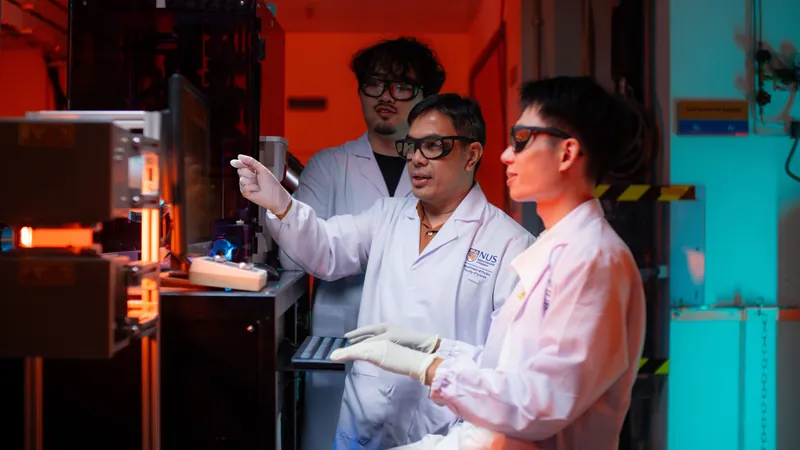
Groundbreaking Discovery: NUS Physicists Unveil Copper-Free High-Temperature Superconducting Oxide!
2025-03-27
Author: Sarah
Groundbreaking Discovery: NUS Physicists Unveil Copper-Free High-Temperature Superconducting Oxide!
In a remarkable leap for the field of superconductivity, researchers Professor Ariando and Dr. Stephen Lin Er Chow from the National University of Singapore (NUS) have successfully designed and synthesized a revolutionary copper-free superconducting oxide. This innovative material exhibits superconductivity at around 40 Kelvin (K), which equates to approximately minus 233 degrees Celsius (°C) under standard atmospheric pressure. This monumental finding cements Singapore’s reputation as a leader in high-temperature superconductivity research.
This discovery comes nearly four decades after the groundbreaking work on copper oxide superconductors, a pioneering effort that was recognized with the Nobel Prize in Physics in 1987. While copper oxides held the key to superconductivity at higher temperatures, the NUS team has expanded the boundaries of what is possible by identifying a new class of superconducting oxides devoid of copper.
The Promise of Superconductors: A Game-Changer for Modern Technologies
Superconductors hold immense potential for modern electronics due to their unique property of exhibiting zero electrical resistance. This means that they can conduct electricity without energy loss, offering a tantalizing solution to the global energy crisis and enhancing the efficiency of electronic devices. Despite the existence of thousands of superconducting materials, most operate only under extremely low temperatures, rendering them impractical for everyday applications.
An Echo of the 1987 Nobel Prize Breakthrough
The landscape of superconductivity was dramatically altered in 1987 when physicists Johannes Bednorz and Karl Müller discovered copper oxides, which operate at significantly higher temperatures than their predecessors. Their Nobel-winning discovery laid the groundwork for subsequent research into high-temperature superconductors, but until now, copper oxides were considered the sole representatives of superconducting oxides above 30 K.
A Breakthrough Beyond Copper: The Future of Superconductivity
In a series of pivotal studies, the NUS researchers identified a vital relationship between interlayer interactions in layered systems and the resultant superconducting temperatures. This insight allowed them to develop a predictive model that forecasted new compounds capable of high-temperature superconductivity without relying on copper.
The team’s success in synthesizing (Sm-Eu-Ca)NiO₂, a nickel oxide, marks a significant milestone; they confirmed that this compound exhibits superconductivity well above 30 K. Dr. Chow expressed excitement, stating, "This non-copper-based superconducting oxide confirms our predictions and operates at atmospheric pressure without the need for additional compression—aligning perfectly with the behavior of copper oxides."
The Implications of the Discovery
"This discovery is revolutionary not just for theoretical advancements but also for practical applications in electronics," commented Professor Ariando. He stressed, "This is the first instance of a copper-free high-temperature superconducting oxide functioning under ambient pressure since the Nobel-winning discoveries. Additionally, the newfound material demonstrates exceptional stability under normal conditions, enhancing its accessibility and potential for widespread use."
Published in the prestigious journal *Nature* on March 20, 2025, this research has ignited excitement within the scientific community, signaling the potential for a new category of high-temperature superconductors. This groundbreaking advancement not only broadens the scope of superconductivity research but also opens doors to practical applications that could redefine energy consumption and electronics in the future.
As we stand on the precipice of a superconducting revolution, the question on everyone’s mind is: What other remarkable discoveries lie ahead as researchers delve deeper into the uncharted territories of unconventional superconductors? The future just got a lot more fascinating!



 Brasil (PT)
Brasil (PT)
 Canada (EN)
Canada (EN)
 Chile (ES)
Chile (ES)
 Česko (CS)
Česko (CS)
 대한민국 (KO)
대한민국 (KO)
 España (ES)
España (ES)
 France (FR)
France (FR)
 Hong Kong (EN)
Hong Kong (EN)
 Italia (IT)
Italia (IT)
 日本 (JA)
日本 (JA)
 Magyarország (HU)
Magyarország (HU)
 Norge (NO)
Norge (NO)
 Polska (PL)
Polska (PL)
 Schweiz (DE)
Schweiz (DE)
 Singapore (EN)
Singapore (EN)
 Sverige (SV)
Sverige (SV)
 Suomi (FI)
Suomi (FI)
 Türkiye (TR)
Türkiye (TR)
 الإمارات العربية المتحدة (AR)
الإمارات العربية المتحدة (AR)